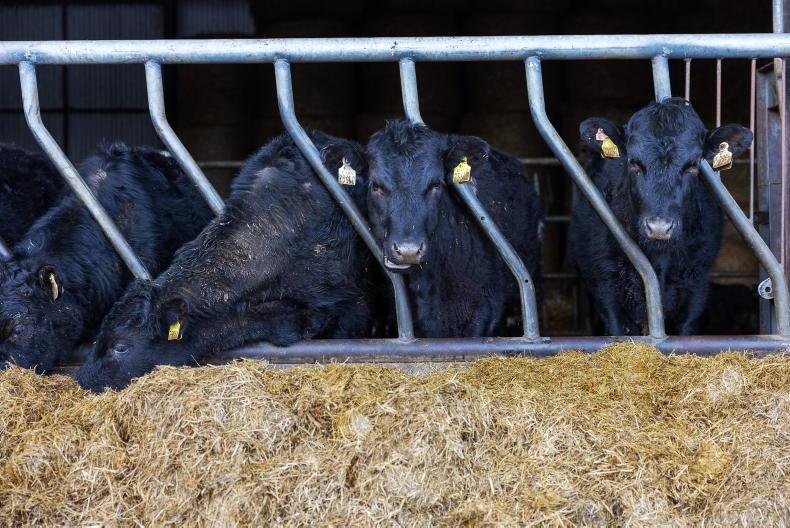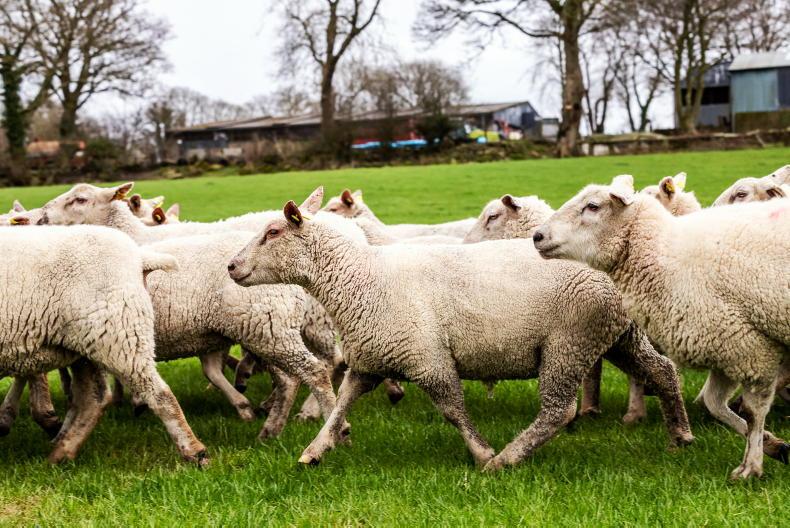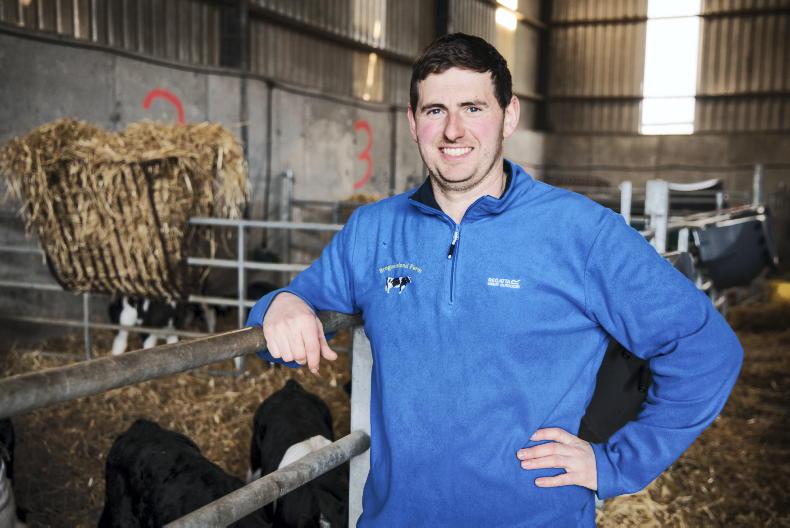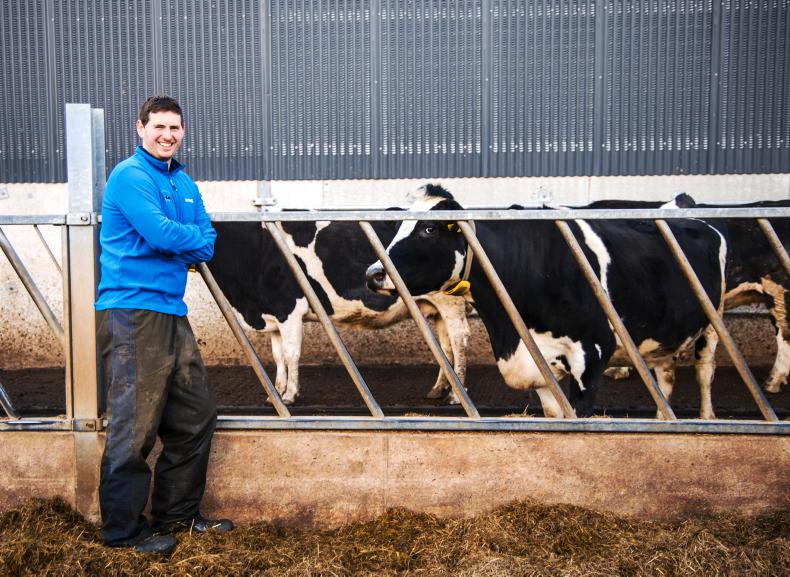In higher-input dairy systems, more typically found in the northern half of the island, concentrates often comprise 60-70% of the variable costs of milk production, so low-concentrate use efficiency results in reduced margins.
With Owen and James Martin operating a fully contained system on their farm at Dromintee, Co Armagh, it is important that they continually pay close attention to how feed is targeted to their herd of 160 cows.
At present, the milking herd is split into two groups, with 100 cows in the high group receiving a total mixed ration (TMR) based on 40kg of first-cut silage (see analysis in Table 1), along with 6kg of blend, 4kg of caustic wheat and straw. The mix is set to deliver maintenance plus 28 litres. On average, the high group also receive 2.25kg of an 18% crude protein nut in the parlour.
The low group are on a TMR based on 44kg of first cut, along with blend, straw and caustic wheat, and an average of 1kg of concentrate fed in the parlour. Across the entire milking herd, cows are currently averaging 28.75l per day.
A total of 60 cows have calved since August, so the majority of the herd are well into their lactation, and average days-in-milk stands at around 200 days. There are 20 cows dry, but most are still in the far-off group.
Margin over concentrate
James recently updated his margin over concentrate (MOC) figures. It is a fairly simple way to monitor herd production costs, and is based on monthly milk sales minus monthly concentrate feed costs.
The results can be expressed on a monthly and rolling annual basis, allowing farmers to keep close tabs on animal performance and feed efficiency, and take rapid action if required.
Farmers in Northern Ireland (NI) can record their data using DAERA online services.
The Martins’ rolling average milk yield currently stands at 9,304l/cow, with milk solids of 691kg/cow and an average of 3.3t/cow of concentrate fed. Feed rate stands at 0.37kg/l. MOC is currently £1,988 (€2,340)/cow/year.
That MOC figure is £100 (€118)/cow up on the same figure from early summer 2021, and is £250 (€294)/cow more than the corresponding figure from November 2020.
While much of that increase is driven by rising milk prices, in any high-input system the key is to ensure that feed is targeted at those cows that can use it most efficiently.
Research
A recent DAERA- and AgriSearch-funded study undertaken by scientists at the Agri-Food and Biosciences Institute (AFBI) looked at performance between August 2018 and August 2019 on 31 NI dairy farmers offering concentrate in feed-to-yield systems.
The work showed that higher yielding cows have greater overall intake potential than lower yielding cows, with silage dry matter intakes decreasing only very slightly as more concentrate is fed. “This broadly supports the adoption of a single ‘Maintenance Plus (M+)’ value for cows in a dairy herd,” state the researchers.
Milk composition
In terms of milk composition, the work showed that as concentrate levels increased, the fat content of milk from both cows and heifers decreased.
Some of this can be explained by genetics, given that farmers in NI have, in the past, put a greater focus on milk yield than on solids.
However, some farms experienced less of a drop in milk fat, so no single factor is responsible for the decrease, state the researchers.
Milk protein percentage was unaffected by concentrate level during the winter feeding period, although it did fall at higher concentrate feed levels when cows were at grass.
High-yielding cows had similar fertility as lower yielding cows in feed-to-yield systems.
Margins
The work concluded that when milk prices are high (around 34p/l (40c/l)), feeding up to 17-18kg of concentrate per day (at £300/t (€350/t)) can make economic sense for the highest-yielding cows in the herd.
At a moderate milk price (around 26p/l (30.5c/l)) the benefit of feeding beyond 14kg was “much reduced”, while at a very low milk price of 18p/l (21c/l), the benefits of feeding more than 12kg to an individual cow “were minimal”. In other words, when milk prices are poor there is little financial gain to be had chasing extra litres.
The researchers also point out that management must be good and rations carefully balanced to ensure high yielding cows fed high levels of concentrate do not move close to a “metabolic tipping point”.
A booklet summarising the work can be downloaded from the AgriSearch website.
Read more
Plan for improved animal health
Targeted sire selection pays dividends
In higher-input dairy systems, more typically found in the northern half of the island, concentrates often comprise 60-70% of the variable costs of milk production, so low-concentrate use efficiency results in reduced margins.
With Owen and James Martin operating a fully contained system on their farm at Dromintee, Co Armagh, it is important that they continually pay close attention to how feed is targeted to their herd of 160 cows.
At present, the milking herd is split into two groups, with 100 cows in the high group receiving a total mixed ration (TMR) based on 40kg of first-cut silage (see analysis in Table 1), along with 6kg of blend, 4kg of caustic wheat and straw. The mix is set to deliver maintenance plus 28 litres. On average, the high group also receive 2.25kg of an 18% crude protein nut in the parlour.
The low group are on a TMR based on 44kg of first cut, along with blend, straw and caustic wheat, and an average of 1kg of concentrate fed in the parlour. Across the entire milking herd, cows are currently averaging 28.75l per day.
A total of 60 cows have calved since August, so the majority of the herd are well into their lactation, and average days-in-milk stands at around 200 days. There are 20 cows dry, but most are still in the far-off group.
Margin over concentrate
James recently updated his margin over concentrate (MOC) figures. It is a fairly simple way to monitor herd production costs, and is based on monthly milk sales minus monthly concentrate feed costs.
The results can be expressed on a monthly and rolling annual basis, allowing farmers to keep close tabs on animal performance and feed efficiency, and take rapid action if required.
Farmers in Northern Ireland (NI) can record their data using DAERA online services.
The Martins’ rolling average milk yield currently stands at 9,304l/cow, with milk solids of 691kg/cow and an average of 3.3t/cow of concentrate fed. Feed rate stands at 0.37kg/l. MOC is currently £1,988 (€2,340)/cow/year.
That MOC figure is £100 (€118)/cow up on the same figure from early summer 2021, and is £250 (€294)/cow more than the corresponding figure from November 2020.
While much of that increase is driven by rising milk prices, in any high-input system the key is to ensure that feed is targeted at those cows that can use it most efficiently.
Research
A recent DAERA- and AgriSearch-funded study undertaken by scientists at the Agri-Food and Biosciences Institute (AFBI) looked at performance between August 2018 and August 2019 on 31 NI dairy farmers offering concentrate in feed-to-yield systems.
The work showed that higher yielding cows have greater overall intake potential than lower yielding cows, with silage dry matter intakes decreasing only very slightly as more concentrate is fed. “This broadly supports the adoption of a single ‘Maintenance Plus (M+)’ value for cows in a dairy herd,” state the researchers.
Milk composition
In terms of milk composition, the work showed that as concentrate levels increased, the fat content of milk from both cows and heifers decreased.
Some of this can be explained by genetics, given that farmers in NI have, in the past, put a greater focus on milk yield than on solids.
However, some farms experienced less of a drop in milk fat, so no single factor is responsible for the decrease, state the researchers.
Milk protein percentage was unaffected by concentrate level during the winter feeding period, although it did fall at higher concentrate feed levels when cows were at grass.
High-yielding cows had similar fertility as lower yielding cows in feed-to-yield systems.
Margins
The work concluded that when milk prices are high (around 34p/l (40c/l)), feeding up to 17-18kg of concentrate per day (at £300/t (€350/t)) can make economic sense for the highest-yielding cows in the herd.
At a moderate milk price (around 26p/l (30.5c/l)) the benefit of feeding beyond 14kg was “much reduced”, while at a very low milk price of 18p/l (21c/l), the benefits of feeding more than 12kg to an individual cow “were minimal”. In other words, when milk prices are poor there is little financial gain to be had chasing extra litres.
The researchers also point out that management must be good and rations carefully balanced to ensure high yielding cows fed high levels of concentrate do not move close to a “metabolic tipping point”.
A booklet summarising the work can be downloaded from the AgriSearch website.
Read more
Plan for improved animal health
Targeted sire selection pays dividends










SHARING OPTIONS